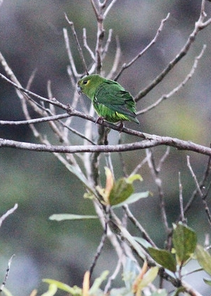Tepui Parrotlet |
|
|
Also known as: Roraima Parrotlet
Photos
View in GalleryDid You Know?
The tepuis or table mountains in the south of Venezuela belong to one of the earth's oldest geologic formations, the "Guyana Shield." The climate on their plateaus differs greatly from that of the surrounding areas, thus isolating the flora and fauna on them.Academic Research
Related publications: Nannopsittaca panychloraSpecies Profile
Genus: Nannopsittaca | Species: panychlora
Size:
14cm (5.5 in)
Weight:
42g.
Subspecies including nominate:
one
Colour Adult:
Both adults mainly green in colour; area around eye green/yellow, more so under eye; yellow wash on forehead, lores and chin, less evident in female; black bend of wing; pale yellow carpal edge. Bill dusky brown. Eye dark brown.
Colour Juvenile:
Undescribed, but thought to be like adults.
Call:
Calls made in flight are continuous, high-pitched tinkling notes, not unlike the jangling of a chain.
Listen NowVideo Links:
Video 1More Information:
Content Sources:
CITES
Dictionary.com
BirdLife International
Cornell Lab of Ornithology/Birds of the World
A Guide to Parrots of the World, Juniper and Parr, 1998
ML Media Collection Catalogue 134920, Tepui Parrotlet Nannopsittaca panychlora, O'Shea, Brian, Guyana, Apr. 11 2001, Cornell Lab of Ornithology. Site
Parrots of the World, Forshaw, 2006. 2010 edition
Lexicon of Parrots, Thomas Arndt.
Photos
View in GalleryDid You Know?
The tepuis or table mountains in the south of Venezuela belong to one of the earth's oldest geologic formations, the "Guyana Shield." The climate on their plateaus differs greatly from that of the surrounding areas, thus isolating the flora and fauna on them.Academic Research
Related publications: Nannopsittaca panychloraSpecies Care
Captive Status:
Extremely rare; probably not kept outside of South America.
Longevity:
Not recorded.
Housing:
Walk-in aviary 3 x 1 x 2m (9.8 x 3.3 x 6.5 ft), planted, with many perches as parrotlets are agile and good fliers.
Diet:
Seed mix such as: wheat, oats, canary, millet and some sunflower; millet spray, dry or sprouted; fruits such as: apple, pear, orange, banana, pomegranate, cactus fruits; vegetables such as: carrot, celery, green beans and peas in the pod; half ripened maize; berries such as: rose hips, mountain ash, Pyracantha; green leaves such as: Swiss chard, lettuce, kale, sowthistle, dandelion, chickweed; complete kibble for small hookbills if taken.
Enrichment:
Provide bird-safe, unsprayed branches such as fir, pine, willow, elder or saskatoon. Provide ladders, swings and ropes for climbing.
Nest Box Size:
Not recorded.
Clutch Size:
Not recorded.
Incubation Time:
Not recorded.
Fledging Age:
Not recorded.
Hatch Weight:
Not recorded.
Peak Weight:
Not recorded.
Weaning Weight:
Not recorded.
Photos
View in GalleryDid You Know?
The tepuis or table mountains in the south of Venezuela belong to one of the earth's oldest geologic formations, the "Guyana Shield." The climate on their plateaus differs greatly from that of the surrounding areas, thus isolating the flora and fauna on them.Academic Research
Related publications: Nannopsittaca panychloraSpecies Wild Status
World Population:
Unknown, stable.
IUCN Red List Status:
Least Concern
CITES Listing:
Appendix II
Threat Summary:
Not globally threatened. A BirdLife “restricted-range” species. Fairly common, with very little trapping. May have declined on the Paria Peninsula due to deforestation.
Range:
SE Venezuela, scattered in tepuis of E Bolivar, including forests of La Gran Sabana and nearby Kamarang River region, W Guyana; also Venezuelan populations in C and S Amazonas and north on Cerro Humo and Cerro Papelon, Sucre. May occur in N Roraima, Brazil.
Habitat:
Found from 750-1850m (2460-6068 ft) in moist montane forest in upper tropical and subtropical zones; also found in lowland areas around the tepuis (table-top mountains found only in the Guyana highlands).
Wild Diet:
Feeds on Ficus figs and the fruits of other trees; birds make altitudinal flights daily from tepuis down to foraging areas.
Ecology and Behaviour:
Gregarious, usually seen in flocks of 100 or more. Makes local or seasonal movements. Probably roosts and nests high on mountain slopes. Difficult to detect while resting or feeding.
Clutch and Egg Size:
Not recorded.
Breeding Season:
Not recorded.
Photos
View in GalleryDid You Know?
The tepuis or table mountains in the south of Venezuela belong to one of the earth's oldest geologic formations, the "Guyana Shield." The climate on their plateaus differs greatly from that of the surrounding areas, thus isolating the flora and fauna on them.Academic Research
Related publications: Nannopsittaca panychloraMembers Only Resources
Please log-in now to find more research, resources and tools.
Not a Member?
Find more great information:
Gain exclusive access to 600+ pages of additional research, seminars and podcasts, specialists to ask your toughest questions, and dozens of other fun resources - when you become a WPT member.
Join Today >>

































